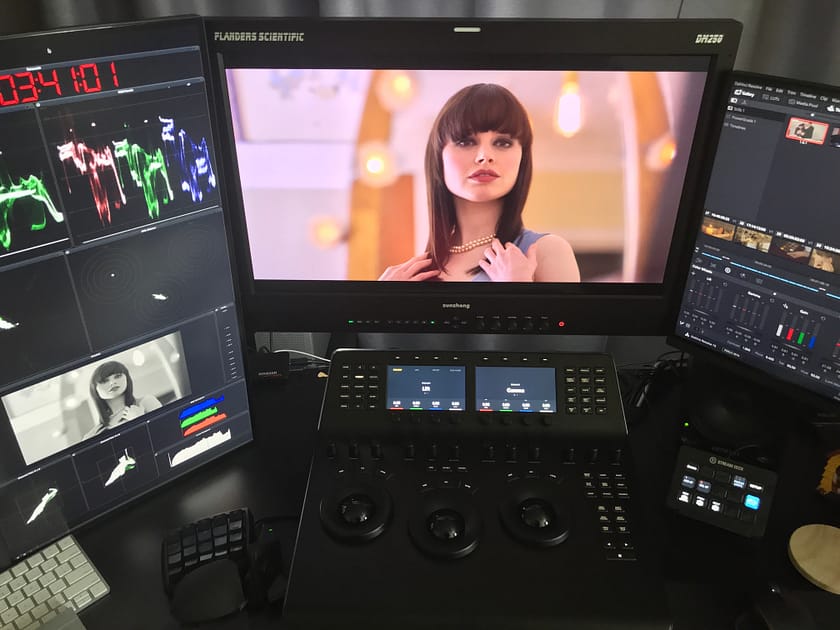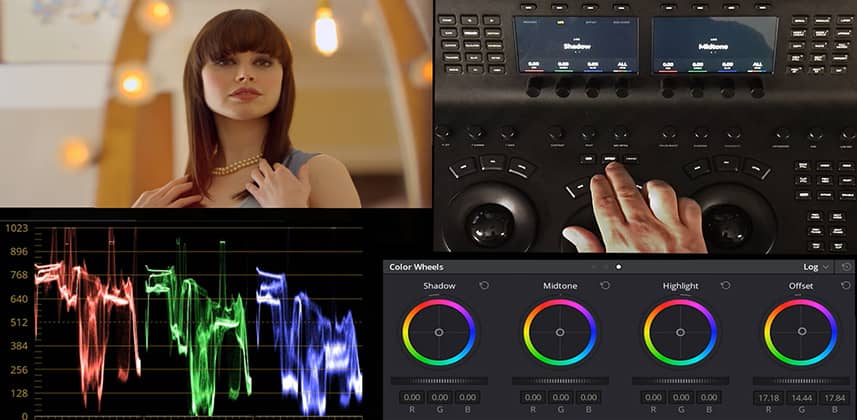| Series |
|---|
Demo’ing Features Unique To Mid-Tier Control Surfaces
It was over a year ago that the DaVinci Resolve Mini and Micro control surfaces started shipping. Mixing Light contributor Joey D’Anna had a terrific overview of the Mini, highlighting its major features. He was followed up by contributor Marc Weilage sharing his thoughts on the Mini, based on several weeks worth of ‘stick time’ and from the perspective of a traditional Hollywood colorist. Both contributors agreed: If you spend considerable amounts of time on Resolve’s Color page then this panel will super-charge your productivity.
One year later, the Mini makes it into my grading suite for the first time. After my first few hours with the Mini and this Insight is my Resolve Mini video review of my first impressions.

Video review of first impressions with the Resolve Mini Colorist Control Surface
In this video review I skip the orientation of the panel layout (if you’d like a more detailed walkthrough then Joey’s and Marc’s Insights, linked above, are your next stop). Instead, I focus on those features that excited me during the first few hours of exploring this hardware.
As I say in the video, when you start working with any control surface your productivity skyrockets. But there’s always a hidden cost…
The hidden cost is that you generally limit yourself to the tools mapped to the control surface. You tend to go to the mouse for the un-mapped tools only when you really, really need them. The Mini panel is reopening tools that I use much less than I would like. Tools that none of the 3rd party panels have mapped to their buttons.
That’s the advantage of the Mini over other panels – including the well designed Tangent Element. You have immediate access to more tools and widgets, without moving the mouse.
Is the Mini worth the cost of upgrading from a Tangent Element?
A full set of 4 Element panels costs almost as much as a Mini, so it’s fair to compare the two. And many pros who own the Element are the target market for the Mini. If you own the full set of Elements then you may wonder if I think it’s worth swapping out to the Mini? In my opinion, it depends on how you’re using DaVinci Resolve:
- Are you working 85% of the time in DaVinci Resolve and more than 50% on the Color page? If that’s you and you already own a full set of Elements? I’d consider selling the Elements and upgrading to the Mini. For you, the Mini will give you a productivity boost worth the net investment. And if you’re spending this much time on the Color page and own any other of the lower priced panels, then the Mini upgrade is a no-brainer. If you’ve got the money – do the upgrade.
- Do you split your time 50/50 between Resolve and one of the other major NLEs? For you, the problem is the Mini only works with Resolve. If you own a full set of Elements I’d keep them (unless you have excess capital laying around that you want to invest). I really like the Elements with Premiere Pro and FCPx. And the one big thing missing from the Resolve Mini is jog functionality, which the Elements excel at (even in DaVinci Resolve). What if you’re making your first big control panel investment and you’re splitting your time 50/50 with other major NLEs? I give the nod to the Tangent Elements, simply for their versatility.
Also in this Video Insight: Informal Colorist Flight School announcement
This Insight is also a dry run for my upcoming Colorist Flight School, which is officially in pre-production. Colorist Flight School is my advanced color grading training program. It’s more than just a Course, it’s interactive between you and me. An integral part of that Program is recreating the experience of sitting next to me and watching me work. This includes watching my hands on the control surface.
This Insight is the first of two dry runs. I’m experimenting with an overhead camera. I’m also working on the presentation of my hands on the control surface, plus the image in the Viewer, and the tool I’m manipulating.
Special Thanks to Flanders Scientific and Blackmagic Design
Because Colorist Flight School is such a popular Program, I reached out to Flanders Scientific and Blackmagic to see if they wanted to support the effort and have Mixing Light feature their latest and greatest gear? And both stepped up to the plate and helped gear-up Mixing Light’s Southern Command Center!
Special Thanks to Flanders Scientific: Since the reference display I’ve been using (the CM250) is no longer for sale, FSI generously upgraded it to the DM250 (although I apologize to FSI, in this video there’s a refresh mismatch between the camera and the display… hence, the purpose of the dry run – helping me build out my pre-recording checklist).
Special Thanks to Blackmagic Design: Since my first Colorist Flight School on Mixing Light is being recorded with DaVinci Resolve, I thought Blackmagic might want to feature the Resolve Mini panel. They agreed. The Resolve Mini you see me working on is generously provided by Blackmagic as a long-term loan.
I greatly appreciate the support and generosity of FSI and BMD. I take it as a sign that they trust I present their products fairly. But I work hard to present their products to you with integrity and honesty.
Use the comments to share your thoughts
Do you have questions about the Resolve Mini? Have you been using it and want to share your observations? Use the comments below! We love the conversations, thoughts and learning inspired by your feedback.
Enjoy!
-pi


